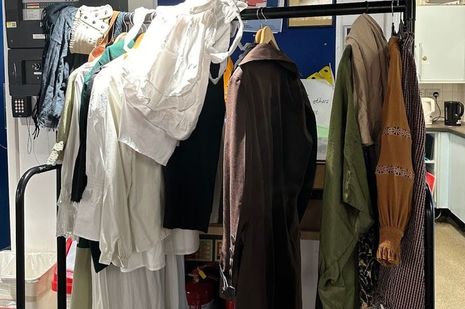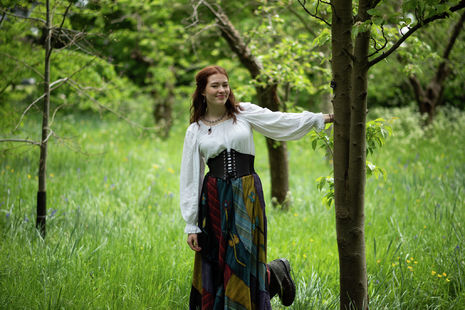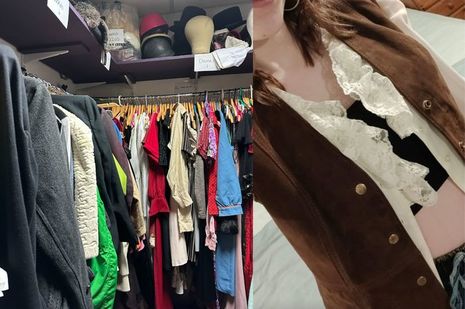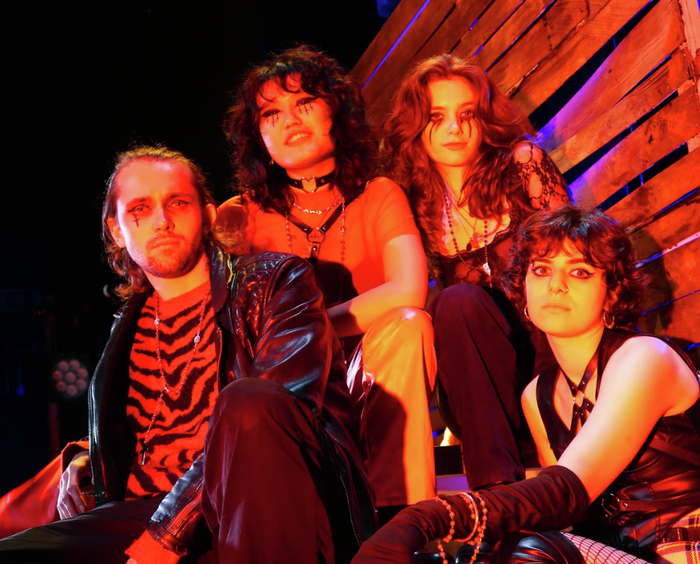Costume designing, how hard can it be?
First-time costume designer Alice Frecheville juggles her love of fashion and theatre

As my theatrical background is firmly in acting, upon discovering Camdram in October, I stubbornly dismissed all adverts for technical roles. I’m a strict technophobe and I’d be a liability as a sound or lighting technician. So, I thought tech roles weren’t for me. That is until I stumbled upon a call-out for the show Devil’s Drum. The premise was intriguing, with the play centred around traditional folk storytelling with a darker gothic twist.
“Like Donatella Versace, I can’t actually sew”
I thought to myself: “Well, I’ve watched enough period dramas and Tim Burton films, analysed enough costumes studying plays for English Lit, and have sufficient awareness of styling to give this a shot.” It seemed like an excellent opportunity to combine two of my favourite hobbies: fashion and theatre. The previous productions I had participated in at Cambridge hadn’t had the luxury of a costume designer, let alone a costume budget!
In Director Izzy Lane’s words, “my vision is to transport the audience out of the comfort of their seats and into the gruesome but beautiful world of forgotten British folklore! I want to thrill and excite, fully immersing the audience and taking them on a journey into the woods.”

While Izzy drew initial aesthetic inspiration from fairground and traveller culture, through the costumes, I also wanted to reference literature and film. I revisited some of my childhood favourites like Into the Woods, Sweeny Todd, Oliver Twist and Jacqueline Wilson’s Victorian novels. A particular inspiration was Ransom Riggs’ Peculiar Children series as the author included eerie, old-timey pictures of children that he sourced at flea markets.
“Keeping the whole cast in period costume while contesting gendered clothing norms was challenging”
Obviously, my first step was to trawl Pinterest. For days, Izzie and I were spamming one another with romantic images of women and children with their hair flowing out of headscarves. We found pictures of long colourful skirts, corsets and grubby street urchins. Of course, we also needed gruesome shots of bloody witches’ skirts.
A key part of costuming Devil’s Drum was creating the skirt of one of the storyteller’s villains, Black Annis, who embellishes it with the skin of her child victims. Lovely.
This task was initially a challenge for me. Like Donatella Versace, I can’t actually sew. Well, at least not with a machine. In a pinch, I can just about hand stitch some fabric onto a skirt, tear it up and drizzle “blood” over it. Luckily, unlike my Year Nine textiles class “finished product”, the more frayed and diabolical the stitching looked on the skirt, the better for the show’s aesthetic. Hence, for all the other garments, I either bought them online or took advantage of the ADC’s well-stocked costume store and the extremely helpful designer’s rep, Jessi.

Fortunately, I was blessed with the expertise of cast member Abi Beton, an extremely gifted costume designer/maker herself. Abi owns an incredible array of folk-style period clothing, from snazzy waistcoats and flowy blouses to steampunk corsets. Her garments were almost as invaluable as the advice she gave me as a first-timer.
Note to all aspiring costume designers: Amazon Prime is a necessity for hunting down niche pieces fast – three red gnome hats in April anybody? On a more sustainable note, Facebook Messenger will be your best friend. The costume designer network in Cambridge is very strong and people will be exceptionally helpful in tracking down items from previous shows for you to re-use or linking you with contacts in college costume stores.
Another key idea Izzy wanted me to signal through costume was gender fluidity and inclusivity. British folklore doesn’t really have much history or traditional representation of gender queerness but this was essential to Izzy’s creative vision. She wanted to welcome actors of all genders and not delineate all the characters as male or female.
Keeping the whole cast in period costume while contesting gendered clothing norms was challenging as British culture has historically incorporated less androgyny into adult clothing than some other cultures. However, by giving several of the female- and gender queer-presenting characters waistcoats and trousers and putting the male-identifying character in eyeliner and jewellery, I could add an androgynous influence to the costumes while maintaining a level of period accuracy.
So far, I’ve enjoyed costume designing so much that I’ve signed up to costume another three shows including Queens’ May Week Shakespeare. It’s a fantastic, relatively low-commitment theatrical role that favours creative collaboration without the pressures of producing or more technological work.
 Comment / Cambridge students are too opinionated 21 April 2025
Comment / Cambridge students are too opinionated 21 April 2025 Interviews / Meet the Chaplain who’s working to make Cambridge a university of sanctuary for refugees20 April 2025
Interviews / Meet the Chaplain who’s working to make Cambridge a university of sanctuary for refugees20 April 2025 News / News in brief: campaigning and drinking20 April 2025
News / News in brief: campaigning and drinking20 April 2025 Comment / Cambridge’s tourism risks commodifying students18 April 2025
Comment / Cambridge’s tourism risks commodifying students18 April 2025 Comment / Cambridge’s gossip culture is a double-edged sword7 April 2025
Comment / Cambridge’s gossip culture is a double-edged sword7 April 2025






